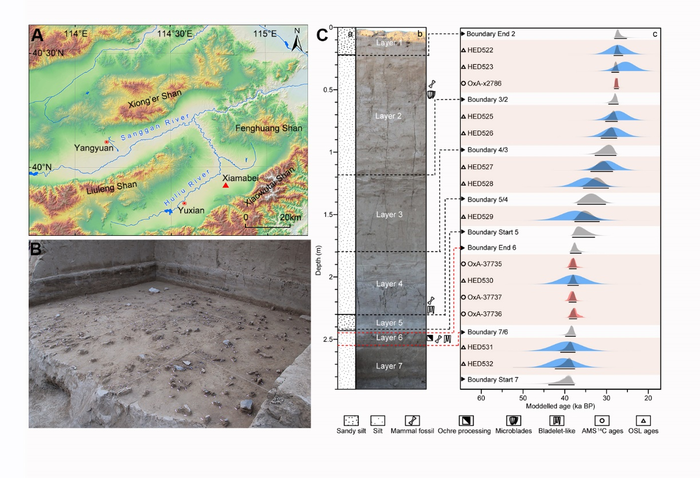A team of researchers from China, Germany, France and Spain, has revealed the lifestyle of humans living in East Asia 40,000 years ago.

Credit: IVPP
A team of researchers from China, Germany, France and Spain, has revealed the lifestyle of humans living in East Asia 40,000 years ago.
The study was published in Nature on Mar. 2.
The study relies on findings from Xiamabei, a well-preserved, ~40,000-year-old archaeological site in the Nihewan Basin, northern China. It was found and excavated by the Hebei Provincial Institute of Cultural Relics and Archeology (HPICRA) in 2013–2014.
“One main layer of the site contains the earliest known ochre-processing feature in East Asia, a distinctive miniaturized stone tool assemblage with bladelet-like tools bearing traces of hafting, and a bone tool,” said Dr. YANG Shixia from the Institute of Vertebrate Paleontology and Paleoanthropology (IVPP) of the Chinese Academy of Sciences (CAS), the co-first and corresponding author of the study.
The Xiamabei findings demonstrate technological innovations and cultural diversification during the worldwide expansion of Homo sapiens and their entry into East Asia.
To establish the chronology of the 290-cm-deep section of the site, the researchers applied two chronological methods, i.e., accelerator mass spectrometry (AMS) radiocarbon dating and optically stimulated luminescence (OSL) dating.
Based on these results, Bayesian analysis showed that the sequence dated to 43,000–28,000 years ago, with the main cultural layer (Layer 6) dating to 41,000–39,000 years ago.
Various scientific methods were used to identify the ochre and the sediment staining. In particular, mineral magnetism (MM) was used to identify the anthropogenic ochre.
With respect to the stone tools, the researchers conducted technological, microscopic use-wear and residue studies. The results indicated that stone tool manufacture was aimed at the production of small items, including blade-like forms, and these miniaturized pieces were hafted.
Interdisciplinary research on the Xiamabei site has provided us a vivid picture of the hunter-gatherer lifestyle 40,000 years ago in North China. People were living in a cool, steppe-like environment. At Xiamabei they conducted activities around a warm campfire, grinding large quantities of ochre powder, hafting blade-like stone tools to conduct a variety of tasks including hide and plant processing, and, most likely, sharing food, including the meat they hunted.
As shown by DNA and fossil evidence of the Tianyuandong individual, modern humans inhabited northern China about 40,000 years ago; however, little is known about their technology and cultures. The findings from Xiamabei will help us further understand the variety of behavioral adaptations and their complexity in East Asia during this critical period.
Although we don’t know who occupied Xiamabei ~40,000 years ago, the role of Denisovans and Neanderthals cannot be excluded. The most parsimonious hypothesis is that the site was occupied by Homo sapiens, considering the presence of contemporaneous fossils of modern humans at Tianyuandong, ~100 km away.
Journal
Nature
DOI
10.1038/s41586-022-04445-2
Article Title
Innovative ochre processing and tool use in China 40,000 years ago
Article Publication Date
2-Mar-2022




